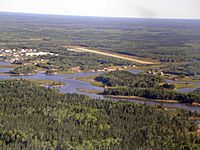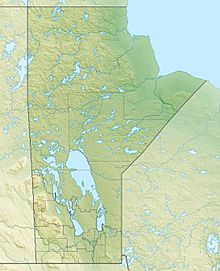Bloodvein First Nation facts for kids

Aerial view of Bloodvein
|
|
| People | Saulteaux |
|---|---|
| Treaty | Treaty 5 |
| Land | |
| Main reserve | Bloodvein 12 |
| Land area | 16.252 km2 |
| Population (2019) | |
| On reserve | 1,176 |
| Off reserve | 742 |
| Total population | 1,918 |
| Government | |
| Chief | Derek Cook |
The Bloodvein First Nation is a vibrant First Nations community. It is located on the eastern side of Lake Winnipeg in Manitoba, Canada. The community sits right along the beautiful Bloodvein River.
This area is home to many amazing animals like caribou, bears, wolves, and bald eagles. You can also find lynx, owls, and many different kinds of fish here. The river and its surroundings have been the traditional lands for the Ojibwa people for a very long time. The community is connected to other places by the Bloodvein River Airport.
Contents
Exploring Bloodvein First Nation's Past
The land where the Bloodvein First Nation is located has a rich history. It is part of Treaty 5, an agreement made between Indigenous peoples and the Canadian government. People have lived in this area for thousands of years.
How the Bloodvein River Got Its Name
The name Bloodvein was first written down in a journal by the Hudson's Bay Company in 1818–19. The name comes from an important event long ago. There was a big disagreement between the people living at the river's mouth and a nearby group. This event was so significant that it was said the river looked red. Originally, the river was called the "Blood River," but the Hudson's Bay Company later changed it to "Bloodvein."
Life Along the River Through Time
During the 1700s, the Bloodvein River was very important for the fur trade. The Ojibwa people used the river area for trapping animals. The river also served as a route to transport furs. Today, the community of Bloodvein is still home to the descendants of the Saulteaux-Ojibwa people. They continue to follow traditional ways of life, including hunting, trapping, fishing, and harvesting wild rice.
A Special River: Canadian Heritage Status
The Bloodvein River flows through one of the largest untouched boreal forest areas in the world. These forests are vital for the planet's health. In 1987, the Bloodvein River became Manitoba's first Canadian Heritage River. This means it is recognized for its natural beauty and cultural importance. A large part of the river is also protected within Atikaki Provincial Park.
Ancient Art and History on Rocks
The river area holds many undisturbed archaeological sites. These sites show us that hunter-gatherer peoples lived here thousands of years ago. You can find pictographs (ancient rock paintings made with red ochre) that date back to around 900 to 1200 AD. These paintings are like messages from the past, telling stories of the people who lived here long ago.
Community Life and Location
The Bloodvein First Nation is a growing community. As of March 2013, there were 1,673 registered members. About 1,042 members lived on their reserve, and 631 lived off-reserve. The main language spoken by the community is Saulteaux.
The Bloodvein Reserve and Its Government
The First Nation's main reserve is called Bloodvein 12. It covers an area of about 3,885 acres. The Bloodvein First Nation is part of the Southeast Resource Development Council. The community is led by a Chief and four councilors who help make decisions for the people.
Connecting the Community
In 2009, work began to improve the Rice River Road that leads to Bloodvein. There were also plans to extend this road further to Berens River. These road improvements help connect the community and make travel easier for everyone.


